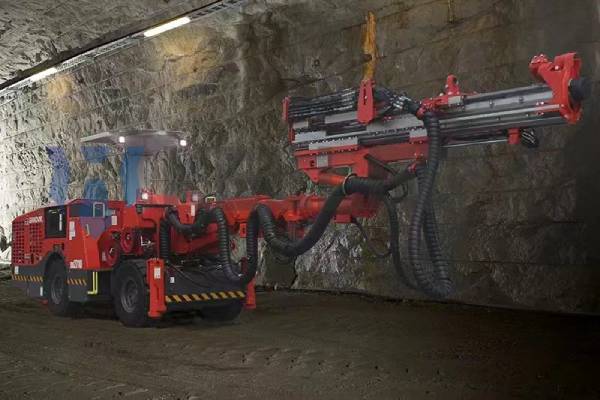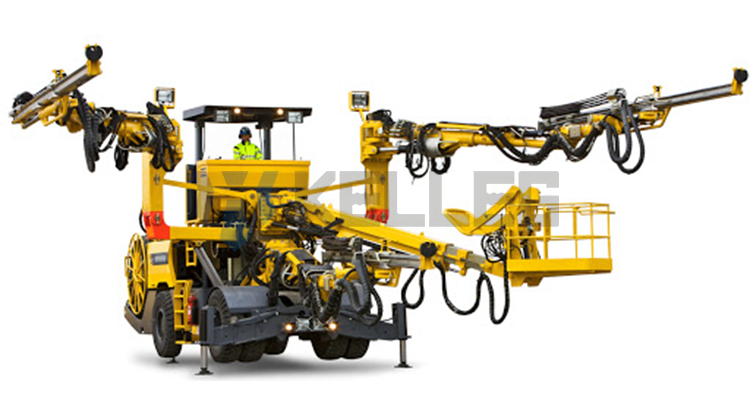2020 官网升级中!现在您访问官网的浏览器设备分辨率宽度低于1280px请使用高分辨率宽度访问。
To realize the mechanization of mining and flat road excavation work, hydraulic tunneling jumbos have appeared and have increasingly become the main rock drilling equipment for underground excavation projects such as underground mine roadways, railway and highway tunnels, and hydraulic culverts. It can be said that the application of hydraulic tunneling jumbo is the embodiment of the modernization level of construction.

Classification of hydraulic tunneling jumbo
1. Hydraulic tunneling jumbos are divided into pneumatic and hydraulic according to the power.
2. According to the applicable roadway section, it is divided into five types: micro (<6㎡), small (6-20㎡), medium (10-50㎡), large (12-70㎡), and extra-large (18-150㎡).
3. According to the walking chassis, hydraulic tunneling jumbo is divided into four types: rail-wheel type, tire type, crawler type, and gantry type.

To give full play to the working efficiency of hydraulic tunneling jumbo and to protect the personal safety of operators, it is important to understand how to use hydraulic tunneling jumbo.
Preparation before use
1. Before entering the working surface, deal with loose stones and debris on the working surface, clean up the roadway, check whether the track installation meets the requirements, and the distance between the front end of track and the most concave part of rocks on the working surface should not be more than 2.5m.
2. Turn on the power and drive drill jumbo to the working surface, then use rail to fix drill jumbo in the proper position, the front wheel axis is not more than 2.5m from the working surface or make the top of the slide frame not more than 0.5m from the working surface.
3. Check whether oil tank storage is sufficient. If oil level is lower than indicated scale, the qualified hydraulic oil should be replenished in time.
4. Each lubrication part should be filled with lubricating oil, to prevent friction parts from burning out because of not filling oil in time.
5. Connect the gas and water pipes. When connecting gas pipes, you should send gas to blow clean debris such as mud and sand in the pipe to avoid damaging the pneumatic equipment.
6. Prepare drill rods, rock drill bits, necessary tools, and wearing parts.
7. Before rock drilling, conduct a trial run of the hydraulic tunneling jumbo. Check whether the parts of each department are intact and whether the fastening parts are loose. Screws on each motor coupling and the two tie rod nuts of drill jumbo must not have any loose phenomenon. Check whether there is any leakage in the gas, water, and oil circuit system, and if there is any abnormality, it should be dealt with before starting production.
8. Connect the lighting.
How to use hydraulic tunneling jumbo?
1. Drill jumbo operator must be familiar with the role and position of each operation valve, to operate drill jumbo accurately.
2. Strictly follow the operation sequence of pump opening, lifts, pendulum supports, jack supports cobalt openings, and closing pumps (except booster pumps).
3. To ensure that the slide frame is always tightened to the working surface when drilling, the control handle of cylinder (oil cylinder) is always triggered to the forward position, for the drilling carriage with oil cylinder should also make the oil pump motor control to run at low speed to input a small amount of hydraulic oil to make up for the leakage of cylinder.
4. Regulator for piston-type pneumatic motor should be adjusted so that the working pressure of the oil is at 5.5MPa. In general, do not trigger the air valve handle. However, when air pressure is insufficient, you can increase the amount of air. After air pressure is increased, return the air to the normal value. Do not adjust the valve to the maximum position and ignore it, not only wastes pressure gas but also makes the pressure oil do a useless cycle, to the oil temperature increases and damages the high-pressure oil pipe.
5. Before each hole is drilled, the hole position and direction must be accurately found, and the orientation should not be adjusted at will during drilling to avoid accidents of stuck and broken drills.
6. When drill is stuck, turn off gas (oil) source of propulsion and pull out drill rod with the propulsion cylinder while knocking the rod with a hammer, and do not pull out drill rod with the compensation cylinder.
7. During rock drilling operations, always pay attention to whether the connection between stabilizer device and various parts is firm and whether the oil temperature and pressure are too high.
8. During the operation of drill jumbo, oil should be injected into each oil injection part at any time. Running parts such as propulsion air motor, rock drill, pallet, screw, and drill arm should be oiled more than twice a shift.
9. When swinging drill arm and slide frame, make sure to return the slide frame so that tip leaves the working surface. Movement of drill arm shift must be accurate and be careful not to make the two drill arms touch violently.
10. When drill jumbo is working, it is strictly forbidden to stand around drill jumbo and under drill arm to prevent people from being bruised or crushed.
11. After rock drilling operation is finished, the two arms are gathered together, slide frame is returned and is in a horizontal position, gas hose is organized, and all parts of drill jumbo are blown and cleaned (pay attention to prevent water and dirt from entering the tank), then drill rod is withdrawn from the working surface and parked in a safe place to avoid damage from flying stones and loose stones falling when the gun is released.
12. When using a locomotive to pull drill jumbo for long-distance operation, the walking handle should be put into neutral position to reduce the driving resistance.
13. After stopping rock drilling, the operator must disconnect the switch on the drilling rig and the switch of the main power supply when leaving the drilling rig avoid oil leakage and electricity leakage, etc.